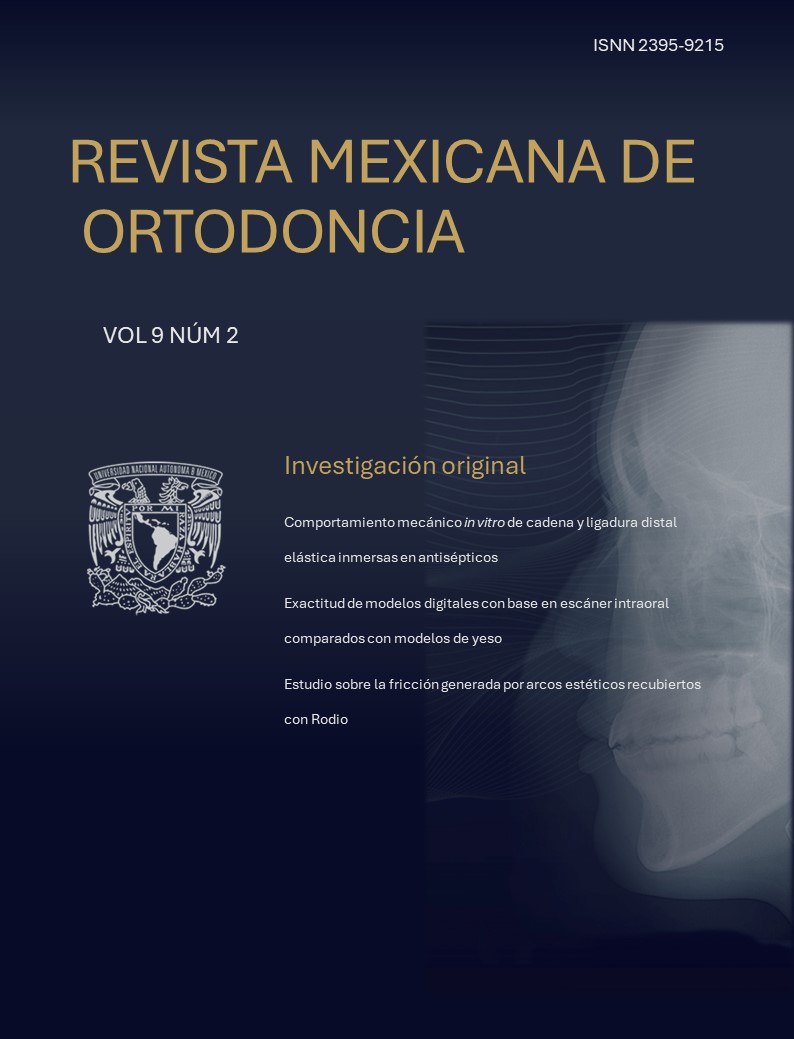Study on the Friction Generated by Aesthetic Arches Covered with Rhodium
Main Article Content
Abstract
Introduction: Aesthetic metal archwires are more discreet than conventional metal archwires. One of the most commonly used aesthetic metal archwires in orthodontics consists of a rhodium-coated Nickel Titanium (NiTi) alloy core. Rhodium is an extremely hard metal and has a high reflectance, making the NITi metal archwire with rhodium coating an aesthetic solution for orthodontic treatment. Objective: To present the evaluation of the friction generated on three types of arches. Materials and Methods: An experimental design was performed using 30 archwires of 0.016" x 0.022" of three different characteristics: NiTi without esthetic coating, NiTi with rhodium coating, and NiTi with Teflon coating. These archwires were placed in 20 experimental models made of acrylic to which 40 brackets In-Ovation R ® (Dentsply Sirona) slot 0.018x 0.025" were placed. To simulate oral conditions the archwires were pulled at different distances: 3mm, 6mm, 7mm, and 8mm at a speed of 10 mm/min in the deflection testing machine using artificial saliva at 25°C as lubricant and the friction generated was measured. Results: The results showed statistically significant differences in the friction generated by uncoated NiTi archwires when compared to NiTi with rhodium and Teflon coating (p>0.0001) Conclusions: Orthodontic archwires with rhodium coating are more aesthetic and do not alter the original dimensions or properties of the wires. Rhodium coating generates less friction in orthodontic tooth movement.
Article Details
Citas en Dimensions Service
References
Kusy RP. A review of contemporary archwires: Their properties and characteristics. Angle Orthod. 1997;67(3):197-207.
Nishio C, da Motta AFJ, Elias CN, Mucha JN. In vitro evaluation of frictional forces between archwires and ceramic brackets. Am J Orthod Dentofacial Orthop. 2004;125(1):56-64. DOI: 10.1016/j.ajodo.2003.01.005
Elayyan F, Silikas N, Bearn D. Mechanical properties of coated superelastic archwires in conventional and self-ligating orthodontic brackets. Am J Orthod Dentofacial Orthop. 2010;137(2):213-7. DOI: 10.1016/j.ajodo.2008.01.026
Fallis DW, Kusy RP. Variation in flexural properties of photo-pultruded composite archwires: analyses of round and rectangular profiles. J Mater Sci Mater Med. 2000; 11(11): 683-693. DOI: 10.1023/a:1008903224180
Imai T, Watari F, Yamagata S, Kobayashi M, Nagayama K, Nakamura S. Effects of water immersion on mechanical properties of new esthetic orthodontic wire. Am J Orthod Dentofacial Orthop. 1999;116(5):533-538. DOI: 10.1016/s0889-5406(99)70185-x
Krishnan V, Krishnan A, Remya R, Ravikumar KK, Nair SA, Shibli SMA, et al. Development and evaluation of two PVD-coated beta-titanium orthodontic archwires for fluoride-induced corrosion protection. Acta Biomater. 2011;7(4):1913-1927. DOI: 10.1016/j.actbio.2010.11.026
Walker MP, White RJ, Kula KS. Effect of fluoride prophylactic agents on the mechanical properties of nickel-titanium-based orthodontic wires. Am J Orthod Dentofacial Orthop. 2005;127(6):662-669. DOI: 10.1016/j.ajodo.2005.01.015
Teramoto, A. Sentalloy, the story of superelasticity. A white paper report. [Internet]. Bohemia, NY: Dentsply GAC, 2010. Disponible en: https://www.dentsplysirona.com/content/dam/master/education/documents/upload/W/WHITE-PAPER---SENTALLOY---The-story-of-Superelasticity-by-Dr-Alberto-Teramoto-lnbffjq-en-1509.pdf
Iijima M, Muguruma T, Brantley W, Choe HC, Nakagaki S, Alapati SB, et al. Effect of coating on properties of esthetic orthodontic nickel-titanium wires. Angle Orthod. 2012;82(2):319-325.
International Union of pure and applied chemistry. Periodic table of elements [Internet]. [Consultado Marzo 5, 2024]. Disponible en: https://iupac.org/what-we-do/periodic-table-of-elements/
Muguruma T, Iijima M, Yuasa T, Kawaguchi K, Mizoguchi I. Characterization of the coatings covering esthetic orthodontic archwires and their influence on the bending and frictional properties. Angle Orthod. 2017;87(4):610-617. DOI: 10.2319/022416-161.1
da Silva DL, Mattos CT, Sant' Anna EF, Ruellas AC, Elias CN. Cross-section dimensions and mechanical properties of esthetic orthodontic coated archwires. Am J Orthod Dentofacial Orthop. 2013;143(4Suppl):S85-S91. DOI: 10.1016/j.ajodo.2012.09.009
Kuftinec MM. Making a good use of a good material: BioForce® arch wires. [Bohemia, NY]: GAC, 2008. Disponible en: https://www.dentsplysirona.com/content/dam/master/education/documents/upload/W/WP---Making-a-Good-Use-of-a-good-material---Bio-Force-archwires-by-Mladen-Kuftinec-qg5cltu-en-1509.pdf
Kusy RP, Whitley JQ. Influence of archwire and bracket dimensions on sliding mechanics: derivations and determinations of the critical contact angles for binding. Eur J Orthod. 1999;21(2):199-208. DOI: 10.1093/ejo/21.2.199
